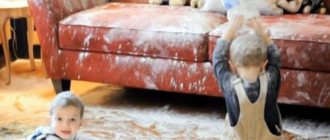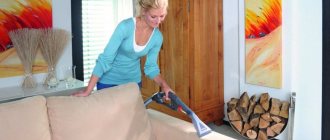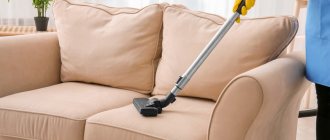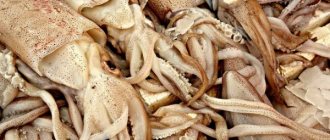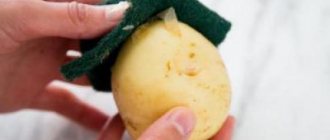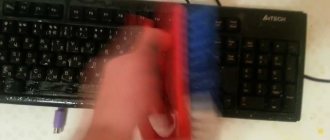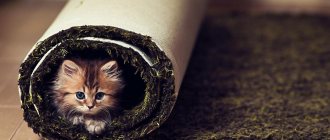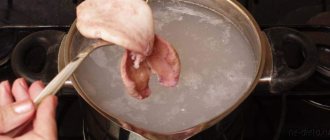Share on social media networks:
Upholstered furniture is an integral component of any interior. It’s so nice to come home and relax on a comfortable sofa or chair in front of the TV, watching movies, TV shows, or just reading a book and talking with family. Often, any of these processes is accompanied by dinner or coffee with various delicacies. As a result, over time, stains inevitably appear on the upholstery, which spoil the appearance of not only the furniture itself, but the entire room as a whole. If you are already overwhelmed by this thought, then it’s time to figure out how to clean the flock on the sofa, because most often this material is used to make upholstery for upholstered furniture.
What kind of fabric is this?
Flock is one of the most popular upholstery fabrics for upholstered furniture, characterized by ease of use, long service life and low price.
Flock is a finely chopped pile that is glued to the fabric. According to tactile sensations, the flock is soft. Depending on the shape and length of the pile particles, the material can have a different original texture, reminiscent of artificial velvet, velor, plush or boucle. It features a modern design and a large number of colors.
Important! The flock composition is 100% nylon pile, less often nylon, and a base consisting of 65% polyester and 35% cotton.
How to remove a stain from a flock-upholstered sofa
Some stains cannot be removed with soapy water. There are ways to deal with a difficult mud stain if you follow the instructions:
Marks from lipstick, markers, and pens are removed from the upholstery using a low concentration alcohol solution, no more than 10%. Take a napkin, paper or fabric, and wet it. By squeezing out excess moisture, we get rid of the stain. It is strictly forbidden to moisten it too much, otherwise it is easy to damage the adhesive backing and irreversibly damage the pile.
Dirt from food can be easily removed using lemon water, a few drops of juice per liter of clean water. We wet the napkin, treat the surface, wait approximately 15 minutes. The acid contained in the liquid will dissolve the food ingredients, after which all that remains is to clean the fabric with a damp sponge. Once cleaning is complete, the sofa should be completely dry.
If we use special-purpose household chemicals, for example, shampoo for upholstered furniture. We follow the recommendations and instructions on the packaging. We recommend that you first test the shampoo on an inconspicuous place. Liquids containing chlorine must not be used.
Incompetent use of chemicals will lead to harmful consequences, so the ideal option is professional dry cleaning of the sofa at home, performed by competent employees. Ignorance of the basic rules for handling flock upholstery will lead to “baldness” and destroy the base adhesive. If you have the slightest doubt regarding cleaning methods, then let’s clearly admit the obvious - you need to involve cleaning experts. Considering the high cost of upholstered furniture, you should not conduct independent experiments, especially using strong chemicals, as there is a possibility of rendering the item completely unusable.
In order to use the services of our cleaning company in Moscow, or you still have questions, you can contact the managers by phone; +7 (915) 494-64-90 or place an order online. Our specialists will consult you free of charge on any questions you may have and will be able to give professional advice.
Do you want to know the cost of dry cleaning at home in Moscow?
Fill out the form and we will contact you within 5 minutes!
Cleaning methods
There are three methods for cleaning flock sofas:
- The physical method involves beating, knocking out.
- Mechanical - the use of special brushes and a vacuum cleaner.
- The most common is chemical; all shampoos, detergents, chemicals, and improvised means are used here.
Important! With any cleaning method, it is important not to use a large amount of water, since the base of such fabric is still adhesive and may come apart. After any method, it is advisable to walk over the surface with a brush to “fluff” the pile and there are no shiny places left on the surface.
Let's figure out exactly how to clean the flock on the sofa at home.
Distinctive qualities of flock
The material is a composition of natural and synthetic fibers and belongs to non-woven one-sided materials. Nylon, cotton or polyester is used as a durable backing. Thick pile is glued using adhesive composites. The fabric has high tensile strength, does not stretch, but is destroyed under the influence of chemical reagents that damage the adhesive base. Traces of “bald patches” were found, which means the velvet layer began to fall out due to the destruction of the substrate.
Considering the above factors, we strongly recommend:
- Do not use alcohol solutions or pure alcohol for cleaning. It is permissible to use liquids with a very low concentration of alcohols.
- Do not use acetone, benzene or pure gasoline.
- Avoid chemicals containing chloride compounds.
- Refrain from squeezing and mechanical cleaning.
- The dirt must first be dissolved, otherwise there is a high probability of scraping off the dirt, damaging the pile.
Physical method
Since this option does not require the use of any tools, you will need:
- Dust cracker;
- Water;
- Sheet;
- Your power.
Follow these steps:
- Place an unnecessary sheet on the sofa.
- Moisten with water.
- Carefully begin to knock out the dust.
That's all.
Important! Periodically, you need to remove the sheet and rinse it to remove adhered dirt. This entire process must be repeated until the removed sheet is relatively clean after the next knocking out.
Bleaching things
The whitening procedure is not suitable for all items. It uses aggressive substances that spoil the material. Flock cannot be bleached; it will lose its quality, turn pale, and fade. It is recommended to take care of it initially, preventing loss of color, yellowing, and the appearance of a gray tint.
You can refresh the fabric by going over it with a vacuum cleaner. It is useful to use a soft brush that does not damage the structure. It will remove the accumulated layer of dirt and dust. This procedure is not relevant for significant contamination. They require hand washing, using a soap solution and a sponge.
Bleaching things
Mechanical
This method will help you get rid of small pieces of food that have stuck, plasticine left by children and other debris. You will need a specialized brush or vacuum cleaner:
- Use the vacuum cleaner slowly, at medium speed, moving over the entire surface of the pile.
- With a brush, things are different, as you will have to manually remove the stuck threads.
Important! Brush in one direction, moving slowly. The brush provides high-quality, but more time-consuming work.
Features of flock upholstery
Flock is finely chopped fibers of wool, cotton, viscose polyamide, acrylic and other materials. Flock upholstery is produced by applying these same fibers to any surface with glue. This is precisely the main feature of this fabric - its delicacy and the impossibility of using very wet methods for cleaning. The material itself is very strong if you try to tear it or stretch it, but it is very impatient with mechanical stress, and even more so with chemical agents. If you choose the wrong means and methods for cleaning flock, the adhesive base will be destroyed and the velvet layer will simply peel off.
Chemical
This method helps to cope well with various types of contaminants.
Important! Observe the quality of the cleaning product used, the concentration, time and quantity, otherwise traces may remain that will subsequently be impossible to remove, or the fabric will become discolored.
Method 1
One of the easiest options when deciding how to clean the flock on a sofa at home, since the necessary products and tools will certainly be at hand:
- Take water, powder and a soft sponge.
- Stir the ingredients well, wet the sponge, and wipe the base of the flock.
- Wait twenty minutes and wash off with a vacuum cleaner or a specialized brush.
Important! When using the brush, make sure it is damp, not wet. There may be unwanted stains on the sofa.
Method 2
Lemon juice works very well for removing food stains. But it is better to use it on light-colored upholstery, since lightened stains may remain on dark fabric.
Here's how to properly clean flock on a sofa with this product:
- Dilute lemon juice in a liter of water.
- Soak a cotton swab in the solution and apply to the stained area.
- Leave for ten or fifteen minutes to complete the process of dissolving the contamination.
- Wash off with plain water using a soft sponge.
Method 3
Laundry soap - this product always helps out, in all cases, and the situation when you need to clean the flock on the sofa is no exception. For this:
- Grate a piece of laundry soap.
- Dissolve in hot water.
- Treat the base of the fabric and let the solution soak in.
- Clean with a damp cloth.
Important! After treating with soapy water, comb the pile to give it volume.
Method 4
If lipstick, a pen, or a pencil suddenly gets on the surface of your sofa, don’t worry, regular 10% alcohol can handle it.
Soak a cotton pad in the solution and treat the surface. It is possible that the contamination remains, repeat the procedure until it completely disappears.
Method 5
For many things, chewing gum is a bit of a mess, but don't worry, here you can use ice:
- Place the ice in any loose bag.
- Apply to the area with the chewing gum and wait for it to completely harden.
- Remove with a regular teaspoon, but be careful not to damage the lint.
Method 6
Dishwashing liquid does a good job of removing greasy stains and is an excellent option for cleaning flocking on your sofa. It is applied like this:
- Apply a couple of drops to the sofa.
- Give it time for it to be absorbed.
- Remove with a soft, damp cloth.
Important! Since the main function of such a product is to remove grease from dishes, it works in the same way on fabric. Accordingly, this option is best suited if you need to clean the flock on the sofa from oil stains and greasy marks after dinner on upholstered furniture.
Method 7
If you have a washing vacuum cleaner with special attachments for cleaning upholstered furniture, it is also quite suitable for solving the problem of restoring the attractiveness of the flock on the sofa. When using it, follow the instructions from the equipment manufacturer.
Important! It is not at all necessary to add auxiliary cleaning agents.
Method 8
This method is suitable for sofas with different types of upholstery, you just need to choose the right cleaning product from the line of offered manufacturers:
- For very dirty stains, use Amway stain remover. The spray is very effective in this regard.
- “Vanish for carpets.” Dilute in water according to the instructions, treat with a foam sponge and the resulting foam. Once dry, simply vacuum it.
Important! Now they sell “Vanish for carpets”, which does not need to be diluted. Sprinkle it, wait twenty minutes and vacuum it up. There is one drawback, the smell will remain.
Wet self-cleaning of a flock sofa
If the upholstery is catastrophically dirty and the above methods do not give the desired result, follow the following recommendations:
- We take warm water, not hotter than 40 degrees. Add regular soap or laundry detergent to the liquid. Apply the resulting cleaning solution to very dirty parts of the surface. We wait approximately 5 minutes. Using a soft sponge, collect the soap solution along with dust and dirt. It is easy to avoid the formation of streaks if, after the procedure, you wipe the treated area again with a sponge soaked in plain water. Repeat the steps, rinsing the sponge at each stage, until the desired result is achieved. Strong penetration of moisture should not be allowed. Paper towels and microfiber cloths will help dry the surface.
- Second way. You will need an iron and cotton cloth. Let's set the heating mode to the middle position and steam the area, having previously covered the piece to be cleaned with a cloth. Wait until the furniture is completely dry; a hairdryer will speed up drying. If after all the manipulations the flock pile has become shaggy, use a soft brush to smooth the piles, making unidirectional movements with the brush.
The above methods will be useful in the fight against typical stains and will help eliminate abrasions, grease or grease stains, and drips from cream, chocolate, and ice cream. It is possible to prevent the stain from spreading if you treat the area from the edges to the center. Old dirt is moistened in advance with a soap solution, after which it is treated using one of the suitable methods.
